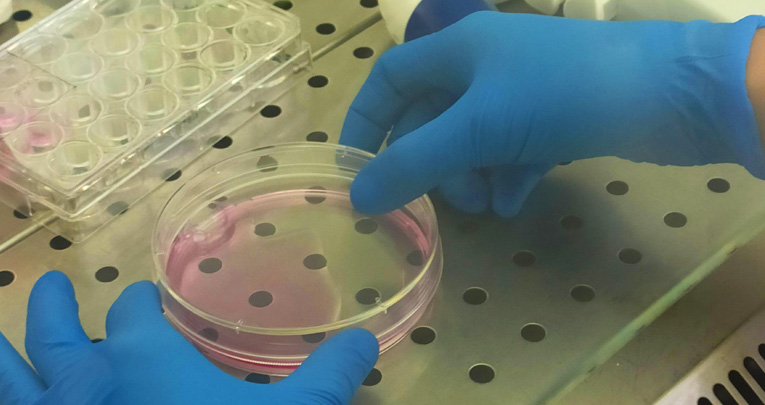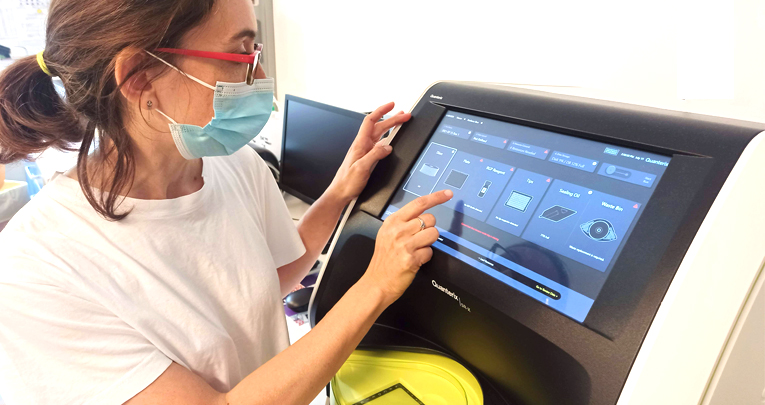Acting Group leader: Alessia Di Sapio

Our research group works closely to the Regional Reference Center for Multiple Sclerosis (CRESM) aiming at improving the diagnosis, predicting the prognosis, personalizing the therapy and studying the pathogenic mechanisms underlying multiple sclerosis (MS) to identify novel therapeutic targets.
MS is a chronic inflammatory demyelinating disease of the central nervous system (SNC) withautoimmune origin and it represents the leading cause of disability of non-traumatic origin in the young adults. MS has heterogeneous phenotypes and unpredictable course. To date there is not a definitive cure. However, there are several drugs which are able to slow down the course of the disease if administered at an early stage.
In this context, our research activity focuses on several aims:
1) Identifying new biomarkers able to anticipate the diagnosis, the prognosis and the response to treatment, in order to give the patient an efficacious personalized therapy at an early stage of the disease.
The Clinical Neurobiology Laboratory performs routine cerebrospinal fluid (CSF) analysis on patients from AOU San Luigi Gonzaga and other Piedmont centers , such as cytological and biochemical CSF analysis and oligoclonal IgG bands detection for evaluation of intrathecal IgG synthesis. CSF analysis is crucial for differential analysis of MS and other neurological disease and for the identification of patients at high risk of developing MS after a first clinical event.
The Clinical neurobiology Lab is involved in the setting up and validation of assays for the detection of autoantibodies related to demyelinating diseases of the CNS in differential diagnosis with MS, such as Neuromyelitis Optica (NMO) and related diseases (NMO spectrum disorders). In our laboratory we evaluated a multiparametric immunofluorescence assay for NMO serology ("Neurology Mosaic 17", Euroimmun), which allows the identification of different AQP4 specific and non-specific patterns, and we set up a FACS assay to evaluate serum anti-myelin olygodendrocytic glycoprotein (MOG) in patients with NMOsd negative for anti-AQP4 antibodies.
Our laboratory is also committed to the r esearch of treatment-response biomarkers in MS patients, aiming at monitoring the biological response to MS-specific drugs and identifying neutralizing anti-drug antibodies . These biomarkers allow to early identify non-responder patients or patients at high risk of developing adverse events, in order to switch for a more efficacious treatment option and optimize the healthcare costs.
In particular, we perform biomarker analyses for the following therapies : beta-interferon (evaluation of biological activity by MxA mRNA analysis and detection of binding and neutralizing anti-drug antibodies), glatiramer acetate (evaluation of biological activity through T-reg cells induction), natalizumab (neutralizing antibodies detection and evaluation of risk to develop PML by detection of anti-JCV antibodies), rituximab (neutralizing antibodies detection, evaluation of biological activity by the quantification of circulating drug and CD19 expression on B lymphocytes).
In last years, in neurological field, the dosage of neurofilaments light chain (NFL) is proving to be a key parameter for patient monitoring. NFLs are proteins of neuron cytoskeleton. Following axonal damage, they are released primarily in the cerebrospinal fluid and secondarily in the blood at very low concentrations.
Recently, the new Simoa (Single-molecule array) technology developed by Quanterix, allows measuring molecules at femtomolar concentrations (fg/mL), i.e. reaching a 1000-fold increase in sensitivity compared to traditional ELISAs. Consequently, the ultra-sensitivity of SIMOA technology allows to quantify NFLs even in the blood: this makes NFLs ideal biomarkers, measurable through a simple blood test.
In 2019, the Clinical Neurobiology laboratory acquired the SR-X Ultra-Sensitive Biomarker Detection System (Quanterix), based on this technology, opening new perspectives to monitor the disease course of neurological patients.
In addition, the ultra-sensitivity of Simoa technology allows numerous applications in many health field, as neurological, cardiovascular, infectious, oncological and immune, increasing the quality and quantity of biomarkers that can be studied in different biological matrices such as serum, CSF and cell extracts.
2) Identifying molecular and biological mechanisms involved in the pathogenesis of MS, which may be the target for future therapeutic approaches.
During pregnancy, women with MS experience major clinical improvement because of the alterations induced in the maternal immune system in order to protect the semi-allogeneic fetus from an immunological attack. Our research activity is committed to clarify the mechanisms underlying this phenomenon. In particular, we identified a set of anti-inflammatory genes whose expression is altered in non-pregnant patients compared to healthy women but reverts to normal during gestation.
We are now investigating the role of these genes in the pathogenesis of MS and the causes underlying their deregulation, taking advantage of MS murine models and blood, placental e post-mortem brain tissues from MS patients and healthy controls.
CRESM Biobank (BB-CRESM)
The availability of biological samples collected and stored following rigorous qualitystandards represents a crucial tool in the field of biomedical and translationalresearch, in order to better understand disease pathogenesis, to identify biomarkers of diagnosis, prognosis and treatment response.
Our group has been involved in the creation of the CRESM Biobank (BB-CRESM): a research biobank is an institutional public structure that aims at collecting, storing and distributing biological samples and associated data following appropriate legal, ethical, clinical, scientific, and technical guidelines.
The BB-CRESM started as a collection of biological samples in the Clinical Neurobiology Laboratory of CRESM since 2013, and it was funded by the Italian Multiple Sclerosis Foundation (FISM) .
Biological samples and associated data are collected from healthy subjects and from MS patients that signed the specific informed consent. All samples and data stored in the BB-CRESM can be distributed to several researchcenters, universities, public or private institutions that may require them to performresearch studies in the field of MS or other neurological or autoimmune diseases.
The BB-CRESM is part of the Italian Node of BBMRI-ERIC (Biobanking and Biomolecular Resources Research Infrastructure) .
News
NURR1-deficient mice have age- and sex-specific behavioral phenotypes
Journal of Neuroscience Research
, 20 May 2022
Open Access
Montarolo F, Martire S, Chiara F, Allegra S, De Francia S, Hoxha E, Tempia F, Capobianco MA, Bertolotto A
Research group NICO: Clinical Neurobiology
Serum neurofilament light chain levels in healthy individuals: A proposal of cut-off values for use in MS clinical practice
Multiple Sclerosis and Related Disorders , September 2021
Valentino P, Marnetto F, Martire S, Malucchi S, Bava CI, Popovic M, Bertolotto A








